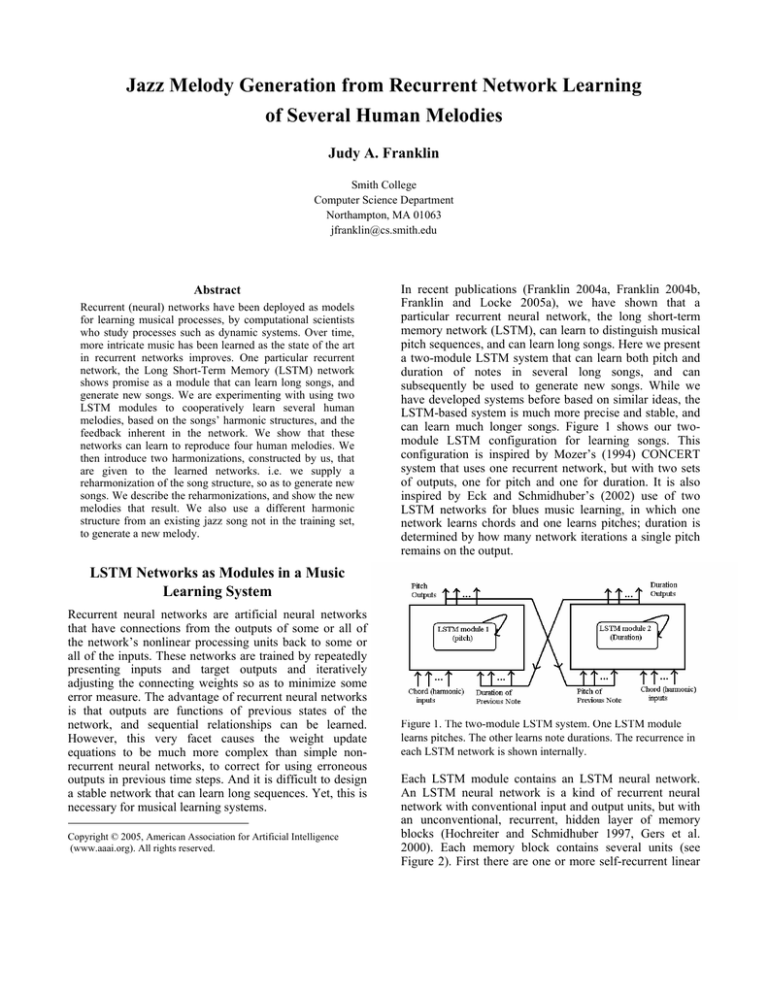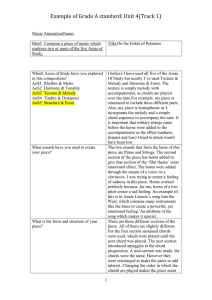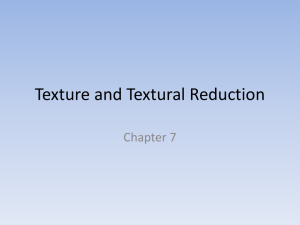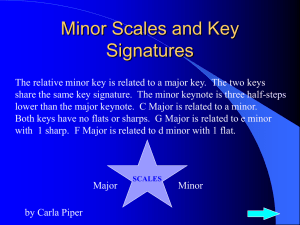
Jazz Melody Generation from Recurrent Network Learning
of Several Human Melodies
Judy A. Franklin
Smith College
Computer Science Department
Northampton, MA 01063
jfranklin@cs.smith.edu
Abstract
Recurrent (neural) networks have been deployed as models
for learning musical processes, by computational scientists
who study processes such as dynamic systems. Over time,
more intricate music has been learned as the state of the art
in recurrent networks improves. One particular recurrent
network, the Long Short-Term Memory (LSTM) network
shows promise as a module that can learn long songs, and
generate new songs. We are experimenting with using two
LSTM modules to cooperatively learn several human
melodies, based on the songs’ harmonic structures, and the
feedback inherent in the network. We show that these
networks can learn to reproduce four human melodies. We
then introduce two harmonizations, constructed by us, that
are given to the learned networks. i.e. we supply a
reharmonization of the song structure, so as to generate new
songs. We describe the reharmonizations, and show the new
melodies that result. We also use a different harmonic
structure from an existing jazz song not in the training set,
to generate a new melody.
In recent publications (Franklin 2004a, Franklin 2004b,
Franklin and Locke 2005a), we have shown that a
particular recurrent neural network, the long short-term
memory network (LSTM), can learn to distinguish musical
pitch sequences, and can learn long songs. Here we present
a two-module LSTM system that can learn both pitch and
duration of notes in several long songs, and can
subsequently be used to generate new songs. While we
have developed systems before based on similar ideas, the
LSTM-based system is much more precise and stable, and
can learn much longer songs. Figure 1 shows our twomodule LSTM configuration for learning songs. This
configuration is inspired by Mozer’s (1994) CONCERT
system that uses one recurrent network, but with two sets
of outputs, one for pitch and one for duration. It is also
inspired by Eck and Schmidhuber’s (2002) use of two
LSTM networks for blues music learning, in which one
network learns chords and one learns pitches; duration is
determined by how many network iterations a single pitch
remains on the output.
LSTM Networks as Modules in a Music
Learning System
Recurrent neural networks are artificial neural networks
that have connections from the outputs of some or all of
the network’s nonlinear processing units back to some or
all of the inputs. These networks are trained by repeatedly
presenting inputs and target outputs and iteratively
adjusting the connecting weights so as to minimize some
error measure. The advantage of recurrent neural networks
is that outputs are functions of previous states of the
network, and sequential relationships can be learned.
However, this very facet causes the weight update
equations to be much more complex than simple nonrecurrent neural networks, to correct for using erroneous
outputs in previous time steps. And it is difficult to design
a stable network that can learn long sequences. Yet, this is
necessary for musical learning systems.
Copyright © 2005, American Association for Artificial Intelligence
(www.aaai.org). All rights reserved.
This Is an Example Second-Level Heading
This is example text. It is 10 point Times Roman. This is
example text. It is 10 point Times Roman. This is example
text. It is 10 point Times Roman. This is example text. It is
10 point Times Roman. This is example text. It is 10 point
Times Roman. This is example text. It is 10 point Times
Roman.
Figure 1. The two-module LSTM system. One LSTM module
learns pitches. The other learns note durations. The recurrence in
each LSTM network is shown internally.
Each LSTM module contains an LSTM neural network.
An LSTM neural network is a kind of recurrent neural
network with conventional input and output units, but with
an unconventional, recurrent, hidden layer of memory
blocks (Hochreiter and Schmidhuber 1997, Gers et al.
2000). Each memory block contains several units (see
Figure 2). First there are one or more self-recurrent linear
memory cells per block. The self-recurrence on each cell
enables it to accumulate numerical values over a series of
iterations of the network. The accumulated data (cell
output) is passed through a nonlinear function. Second,
each block contains three gating units that are typical
sigmoid units, but are used in the unusual way of
controlling access to the memory cells. One gate learns to
control when the cells’ outputs are passed out of the block,
one learns to control when inputs are allowed to pass in to
the cells, and a third one learns when it is appropriate to
reset the memory cells. LSTM's designers were driven by
the desire to design a network that could overcome the
vanishing gradient problem (Hochreiter et al. 2001). Over
time, as gradient information is passed backward to update
weights whose values affect later outputs, the
error/gradient information is continually decreased by
weight update scalar values that are typically less than one.
Because of this, the gradient vanishes. Yet the presence of
an input value way back in time may be the best predictor
of a value far forward in time. LSTM offers a mechanism
where linear units can accumulate and hold important data
without degradation, and release it many iterations later.
Figure 3. Synopsis of forward and backward pass of the LSTM
algorithm.
Figure 2. An LSTM network, and an enlargement of a memory
block containing one memory cell, and the three gating units.
The complete equations for the LSTM network are beyond
the scope of this paper. Hochreiter and Schmidhuber 1997
provide the detailed derivation., Gers et al. 2000 add the
forget gates, and also provide detailed pseudo-code that is
very valuable for implementation. However, a brief
summary of the algorithm is given in Figure 3.
As shown in Figure 1, one LSTM network learns to
reproduce the pitches of one or more songs, and a second
one learns to reproduce the corresponding durations. The
dual system contains recurrence in three places: the interrecurrence at the network level, the recurrence of the
hidden layer of memory blocks, and the self-recurrence of
each memory cell. We showed in previous work (Franklin
2005b) that a similar system, with two LSTM networks
that are not inter-recurrent, can learn both a human
rendition of the song “Afro Blue”, as well as a score-based
version.
The two networks can also learn Afro Blue with and
without the harmonic structure (the chords) given as input.
To expand the system to be able to generate music, we
now tie the pitch and duration networks together, so each
network receives the outputs of the other network, for the
previous note. We also present the harmonic structure
corresponding to the example song to be learned to each
network’s input units. These inputs are the chord over
which the current melody notes are played. The
representations for duration, pitch, and chords are
described in a later section. A small amount of beat
information is given to the networks as one input with
value 1 only if the beginning of a new measure has passed.
Another set of inputs not shown in the diagram are a
binary encoding of the number of the song being learned;
one binary input for each of the four songs, that is 1 only if
that song is the current training example.
The Four Songs
presentation of the songs as examples includes one lead-in
measure so as to include the lead-in notes.
The songs learned by the two-module system are
“Summertime”, “Watermelon Man”, “Blue Bossa”, and
“Cantaloupe Island.” Each song is presented here, as a
musical score of a human rendition of the melody, with the
chord structure. Figures 4 and 5 show the songs
Summertime and Watermelon Man. The human renditions
were obtained from MIDI files found on the web. The
chords for the songs are provided by (Aebersold 2000).
Figure 6. Blue Bossa score, showing human rendition and
harmonic structure.
Figure 4. Summertime score, showing human rendition and
harmonic structure.
Figure 7. Cantaloupe Island score, showing human rendition and
harmonic structure. Notice that the melody does not contain any
notes in the last four bars of the song, although the song has a 16bar harmonic structure.
Figure 5. Watermelon Man score, showing human rendition and
harmonic structure.
Figures 6 and 7 show the other two of the four songs, Blue
Bossa, and Cantaloupe Island. Each song has a different
harmonic structure, although there is some overlap in the
individual chords that appear. Each song is in 4/4 time,
with four beats per bar, and each has 16 bars. Three of the
songs have lead-in notes before the first bar. The
Experimental Details
This section describes the representation of pitch and
duration, as well as the learning parameters for the
experiments.
Pitch Representation
The pitch of the note corresponds to the note’s semi-tone,
from Western tonal music. Pitch must be represented
numerically, and there are many ways to do this from a
musicological point of view (Selfridge-Field 1998). Since
our melody sources are MIDI-based, we often think of
pitches as having an integer value, one value for each
semi-tone, with 60 representing middle-C. But the pitch
must be represented in a way that will enable a recurrent
network to easily distinguish pitches. We have developed
one such representation called Circles of Thirds. We have
experimented with this representation on various musical
tasks, with successful results (Franklin 2004a, Franklin and
Locke, 2005) and have compared it to others such as those
found in (Todd 1991, Mozer 1994, Eck and Schmidhuber
2002).
Figure 8 shows the four circles of major thirds, a major
third being 4 half steps, and the three circles of minor
thirds, a minor third being 3 half steps.
Figure 8. At top, circles of major thirds. At bottom, circles of
minor thirds. A pitch is uniquely represented via these circles,
ignoring octaves.
The representation consists of 7 bits. The first 4 indicate
the circle of major thirds in which the pitch lies, and the
second 3, the circle of minor thirds. The number of the
circle the pitch lies in is encoded. C’s representation is
1000100, indicating major circle 1 and minor circle 1, and
D’s is 0010001, indicating major circle 3, and minor circle
3. D# is 0001100. Octave information is indicated by two
additional bits, one for octave C2-B2 and one for octave
C4-B4. Only one of these bits would be nonzero at a time.
If both are zero, then octave C3-B3 is indicated.
Because the 7th chord tone is so important to jazz, our
chords are the triad plus 7th. In using Circles of Thirds to
represent chords, we could represent chords as four
separate pitches, each with seven bits for a total of 28 bits.
However, it would be left up to the network to learn the
relationship between chord tones. We borrowed from
Laden and Keefe’s (1991) research on overlapping chord
tones as well as Mozer’s (1994) more concise
representation for chords. The result is a representation for
each chord that is 7 values. Each value is the sum of the
number of on bits for each note in the chord. For example,
a C7 chord in a 28 bit Circles of Thirds representation is
1000100 1000010 0001010 0010010
C
E
G
B-flat
The overlapping representation is: 1000100 (C)
1000010 (E)
0001010 (G)
+ 0010010 (B-flat)
2011130 (C7 chord)
This is scaled to produce seven input values between zero
and one: 0.6, 0, 0.3, 0.3, 0.3, 0.9, 0.
Duration Representation
We have also experimented with duration representations
(Franklin 2004b). In our system, the entire note duration is
the output of one LSTM module on one iteration. In our
Modular Duration representation, beat length is divided by
96 giving 96 clicks per quarter note, 48 per eighth note, 32
per eighth note triplet note, etc. We can represent triplets
and swing, and duration variations that occur in human
MIDI performance (Thomson 2004), a step toward
interpreting expressive MIDI performances. Our
representation is a set of 16 binary values. Given a
duration value, dur, the 16th bit is 1 if dur/384 >= 1, where
384 = 96*4, is the duration in clicks of a whole note. Then
the 15th bit is 1 if (dur%384)/288 >= 1. In other words if
the remainder after dividing by 384 and then dividing by
288 is greater than or equal to 1. The 14th bit is 1 if
(dur%384%288)/192 >= 1. The modulo dividers are 384,
288, 192, 96, 64, 48, 32, 24, 16, 12, 8, 6, 4, 3, 2, and 1,
corresponding to whole note, dotted half, half, quarter,
dotted eighth, eighth, eighth triplet, sixteenth, sixteenth
triplet, thirty-second, and then 6, 4, 3, 2, and 1 for
completeness. Any duration that exactly matches, in clicks,
one of these standard score-notated durations can be
represented, as can combinations of them, or human–
performed approximations to them.
Two example durations (in clicks) from Summertime are
86 and 202. The duration 86 is 64+16+6, represented as
0000100010010000, and the representation of 202 is
192+8+2, or 0010000000100010.
Experimental Results
We base the choice of parameters for the two LSTM
modules on those values that worked best in the past on
specific musical tasks and on the learning of the pitch and
duration of the melody of Afro Blue. Consequently, both
of the two LSTM modules contain 20 memory blocks, with
four cells each. The set of four songs is presented for
15000 epochs. The two-module network learns to
reproduce the four songs exactly, with a learning rate of
0.15 on the output units, and a slower rate of 0.05 on all
other units. A larger rate on the output units produces
consistently stable and accurate results in our previous
experiments as well. Once the four songs were learned, we
began experimentation with generating new melodies. In
this network configuration, a straightforward way to do
this is to give the networks a whole new chordal structure.
We keep the inter-recurrent connections and set the four
song inputs all equal to one (all on).
Figure 9. The melody generated by the dual-network system,
over a complex chord structure.
We show melodies that are generated over three different
harmonic structures, in Figures 9-11. The figures also
show the harmonic structure as before. One bar of a pickup or lead-in chord is given in each chord structure, since
three out of four training songs had lead-in notes. Figure 9
shows a melody generated over a fairly complex harmonic
structure that we derived from the structures of the four
learned songs. There is a new chord in every bar except for
the occurrence of F-minor (shown as Fm) two bars in a
row in the second line. The melody depicted is a close
approximation of the actual melody output by the
networks. The approximation is made by the software
used, Band-in-a-Box (PG Music 2004), to enter in the
chords, to import the MIDI file, and to generate the scores
as shown in the figures.
Figure 10 shows a much simpler chord structure also
derived from the four original songs. All chords are carried
over two bars (except the lead-in). The simpler chord
structure results in a melody that is more rhythmic, and
contains more notes. Note the use of grace note-like
triplets that is an influence of the human musicians’ style
of playing. While there are a couple of notes out of place,
such as the initial A on the G7alt chord in the lead-in bar,
and the F# on the G7alt four bars later, the melody notes
are derived from the scales one might associate with the
chords when improvising, and the rhythm is quite
reasonable.
Figure 11 shows the melody generated over a chord
structure of an existing jazz composition, Song for My
Father. This melody is by far the most pleasing to the ear,
due in part to Horace Silver’s (composer of Song for My
Father) experienced use of the F-minor blues chords. But
also, since these chord changes follow patterns and
sequences that occur in the training songs, the network
should be more likely to generate a better melody on them.
We note two bars with a flurry of musical activity, the Eb7
in line 3 where the flurry is rhythmic, and on the Gminor
chord in line 4. These are attractive because human
musicians will often play such riffs in an improvised solo,
but also because they occur within smoother, more melodic
contexts.
Figure 11. The melody generated by the dual-network system, on
the AB part of the AAB structure of Song For My Father.
Figure 10. The melody generated by the dual-network system,
over a simpler chord structure.
Discussion
The melodies generated by the trained network are
interesting and for the most part pleasant. However, there
are several “rough spots” that reveal the inexperience of
the dual LSTM system, in which it “finds itself” in
unknown musical territory. Two possible ways to decrease
these rough spots are 1) to train the network on more
songs, and 2) to employ a reinforcement learning (RL)
mechanism to improve the melody generation. How can
this be done? An RL agent could monitor the phrase
structure produced by a network, such as noticing the two
similar phrases in Figure 9 that both start with C and rise to
G, each over a Fm to Eb7 (ii-I) chord transition, and
reward that network output in some way. We have done
some preliminary work in combining LSTM with a
reinforcement prediction algorithm in which the LSTM
equations are directly altered.
Another idea is to use a simpler, even non-recurrent RL
agent that controls the dual LSTM networks. This agent
could control several networks that are each trained on
several possibly overlapping songs. The RL agent could
choose which network’s output to use for each note, or
phrase. It could also learn to control the network by e.g.
varying the threshold used in the duration network to
choose which outputs are considered to contribute to the
final duration value.
Acknowledgements
This material is based upon work supported by the
National Science Foundation under Grant No. IIS-0222541
and by Smith College. Any opinions, findings, and
conclusions or recommendations expressed in this material
are those of the author and do not necessarily reflect the
views of the National Science Foundation. The author
acknowledges the excellence of the John Payne Music
Center, Brookline, MA for human jazz learning.
References
Aebersold, J. 2000. Maiden Voyage (Vol 54). New Albany, IN :
Jamey Aebersold.
Eck, D. and Schmidhuber, J. 2002. Learning the Long-Term
Structure of the Blues. Proceedings of the 2002 International
Conference on Artificial Neural Networks (ICANN). 284-289.
Engelmore, R., and Morgan, A. eds. 1986. Blackboard Systems.
Reading, Mass.: Addison-Wesley.
Franklin, J. 2004a. Recurrent Neural Networks and Pitch
Representations for Music Tasks, in Special Track: Artificial
Intelligence and Music, in Proceedings of the Florida Artificial
Intelligence Research Symposium, Miami, FL.
Franklin, J. 2004b. Computational Models for Learning Pitch and
Duration Using LSTM Recurrent Neural Networks. in
Proceedings of the 8th International Conference on Music
Perception and Cognition (ICMPC8), Chicago, IL.
Franklin, J. and Locke, K. 2005a. Recurrent Neural Networks for
Musical Pitch Memory and Classification. International Journal
on Artificial Intelligence Tools (IJAIT). To appear, March 2005.
World Scientific Publishing Co. Pte. Ltd. SINGAPORE
Franklin, J. 2005b. Franklin, J. Recurrent Neural Networks for
Music Computation. in INFORMS Journal on Computing,
Special Cluster on Music and Computation. To appear 2005.
Gers, F. A., Schmidhuber, J. and Cummins, F. 2000. Learning to
forget: Continual prediction with LSTM. Neural Computation
12(10): 2451-2471.
Griffith, N. and Todd, P. 1999. Musical Networks: Parallel Distributed Perception and Performance. MIT Press,Cambridge MA.
Hochreiter, S. and Schmidhuber, J. 1997. Long Short-Term
Memory. Neural Computation, 9(8):1735-1780.
Hochreiter, S., Bengio, Y., Frasconi, P., and Schmidhuber, J.
2001. Gradient flow in recurrent nets: the difficulty of learning
long-term dependencies. A Field Guide to Dynamical Recurrent
Networks. IEEE Press, New York, NY.
Laden, B., & Keefe, D.H., 1991. The Representation of Pitch in a
Neural Net Model of Chord Classification. Music and
Connectionism, Todd,P.M., Loy,E.D., eds.,Cambridge, MA. MIT
Press.
Mozer, M. C., 1994. Neural Network Music Composition by
Prediction: Exploring the Benefits of Psychophysical Constraints
and Multiscale Processing. Connection Science, 6, 247-280
Todd, P. M., & Loy, E. D., 1991. Music and Connectionism,
Cambridge, MA: MIT Press.
Selfridge-Field, E. 1998. Conceptual and Representational Issues
in Melodic Comparison. In Melodic Similarity. Concepts,
Procedures, and Applications. Computing in Musicology 11.
Hewlett, W. and Selfridge-Field, E., eds. Cambridge MA, MIT
Press.
Todd, P. M., 1991. A Connectionist Approach to Algorithmic
Composition, Music and Connectionism, eds.: Todd, P.M. and
Loy, E. D., Cambridge, MA, MIT Press.










